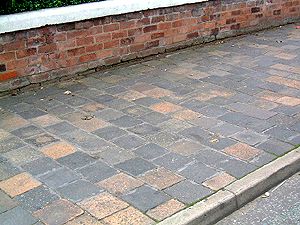Page 1 of 1
Posted: Sun Apr 20, 2003 8:05 am
by 73-1093879375
When replacing the downstairs floor in my 1910 terrace house I rescued the original brick tiles (made locally up the road in Kings Heath) and have intended to use them for a patio. They're just over 9" square and about 1.5" thick. I've laid compacted subbase and concrete to set them on but...
It's occurred to me that they may not be frost-proof, having been designed for interior use. Should I use them after all? It would be a shame not to. I was thinking about treating them with something like Thomson's Water Seal.
I don't want to get them down and then find they start falling apart :-(
Any suggestions greatly appreciated.
Thanks,
Ivan.
Posted: Mon Apr 21, 2003 2:13 pm
by 84-1093879891
Do they have a very smooth 'tight' finish, Ivan, or a semi-glazed look? If so they are probably suitable for external use, A photo, if poss, might help in identifying them.
Personally, I wouldn't use Water Seal on them, I'd leave them open to the weather for a year and see how they fare before condemning them to a life beneath varnish. If I did choose to use a sealant, I would choose a purpose-designed proven sealant for paving rather than a 'jack-of-all-trades' product, but that's not to say that Water Seal wouldn't work.
Posted: Mon Apr 21, 2003 10:05 pm
by 73-1093879375
They have a fairly smooth finish, not really a glazed look. I've posted a picture of one here:
http://ivanlouise.pwp.blueyonder.co.uk/tile.JPG
Ivan.
Posted: Tue Apr 22, 2003 10:02 am
by 84-1093879891
That looks fine. It's in very good condition for a salvaged tile, and I think it will be ok outdoors. Are you going to bed them on mortar, or lay them 'dry' like modern block paving?
Posted: Tue Apr 22, 2003 11:09 am
by 73-1093879375
I've never layed tiles before. I was intending to bed them on mortar. There is some variability in their thicknesses and so I thought that mortar would give me a fighting chance of getting a flush surface. Or do you think I would find it easier to use a dry mix?
Posted: Tue Apr 22, 2003 9:29 pm
by 84-1093879891
They are very similar to a unique pavers used for many of the older footpaths in and around Southport, which go by the stunningly original name of 'Southport Pavers'. We relaid thousands of square metres of them back in the 1980s, and we found that the best method was to use a semi-dry bedding mix, and to butter the receiving edges of each tile as they were laid, just as is described on the
Laying Flags page.
Here's a pic of the Southport Pavers....

A rubber clonker is an essential tool and use a taut string line to guide your levels. We pointed up the joints within an hour of laying, using a black lime mortar, but you could use a standard cement mortar with added dye to give you your chosen colouring. Make the bedding barely damp, and use the clonker to tap down each tile to the correct level. Complete one course at a time, and don't rush it. You have to live with your work for a good few years, so it's worth spending a copuple of extra hours if necessary, to get it just right.
Send me a few pictures when you get it done, and, if you need any further guidance, just ask. :)
